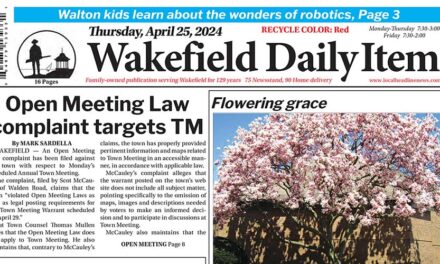Published in the August 12, 2016 edition.
By GAIL LOWE
OAK ISLAND, Nova Scotia — Who doesn’t love a good mystery? Like any intriguing puzzle, they’re hard to resist.
There’s a buried treasure mystery surrounding Oak Island in Nova Scotia’s Mahone Bay that’s so intriguing it has prompted the airing of a reality television series on the History Channel called “The Curse of Oak Island.”
The show premiered on Jan. 5, 2014 and will enter its fourth season in the fall.
Oak Island is a tiny island on the Atlantic side of Nova Scotia just south of Halifax and slightly north of Lunenberg where the Bluenose is dry-docked.
Accessible only by an 840-foot causeway, permission must be granted for entrance onto the island. Interest in the TV show and the buried treasure that could be the plunder of the Knights Templar has run so high that the Friends of Oak Island Society found a way to satisfy the “permission only” requirement by opening the island to group tours. Devoted viewers of the show can now buy tickets at $15 per person and visit the various spots with Tour Guide Charlie Barkhouse, including the Money Pit and Borehole 10-X, locations where drillings hundreds of feet below the ground have taken place.
While on tour, Barkhouse, also one of the show’s stars, told a story about Samuel Ball, a former slave turned cabbage farmer on Oak Island who may have already found the treasure. He bought multiple acres of the island, but where did he get the money? Pondering this and other questions only deepens the mystery. During the hour-long walk, Barkhouse also spoke about the geology of the island and pointed out Smith’s Cove, an artificial beach believed to flood underground tunnels, including the Money Pit.
The two top stars of “The Curse of Oak Island” are two brothers from Michigan — Rick and Marty Lagina — who learned about the supposed buried treasure on Oak Island during childhood. By the time the brothers reached adulthood, their interest in the legends and tales surrounding the buried treasure deepened.
Over the years, Marty became a successful businessman and decided to help his brother Rick find the lost treasure. He bought an interest in the island and was then approached by producers from the History Channel to air a show about the treasure hunt. Now, a portion of the tiny island belongs to the Lagina brothers. The remainder of the land continues to be residential property.
For the past four years, Rick and Marty have taken up where others before them left off. But their dig is like none other. They’ve brought in heavy equipment, including bulldozers, boring machines and excavators plus world renowned divers willing to go into narrow tunnels hundreds of feet below ground to help solve the mystery, a mystery that started 220 years ago and might even involve the Knights Templar.
The supposed treasure is buried somewhere on the island, but the nature of the treasure is far from clear — it could be anything, from pirate gold to King Solomon’s temple treasure, Marie Antoinette’s lost jewels and Shakespearean manuscripts. Perhaps even the Holy Grail is buried there. Numerous small discoveries and clues have been found but no signs of the major booty — yet.
The mystery of Oak Island began in the summer of 1795 when teenager Daniel McGinnis was wandering around the island and came across a curious circular depression in the ground. Towering over this depression was a tree whose branches had been cut in such a way that it looked like it had been used as a pulley. Having heard tales of pirates in the area, McGinnis went home and told friends about the tree and the group returned later to investigate the depression. Over the next few days McGinnis, along with friends John Smith and Anthony Vaughn, dug deeper into the depression. What they found was nothing short of astonishing. Two feet below the surface, they came across a layer of flagstones covering the pit. At 10 feet down they ran into a layer of oak logs spanning the pit. Again at 20 feet and 30 feet they found another layer of logs. They were unable to continue the exploration alone and called it a day but with plans to return to continue the search. Eight years later, they were back with The Onslow Company and the group formed for the purpose of searching for the treasure. The dig got underway again, and at every 10-foot interval, more oak layers were discovered. That’s not all. At 40 feet, they found a layer of charcoal; at 50 feet a layer of putty and at 60 feet a layer of coconut fiber. Then, at 90 feet, the most puzzling clue of all was found – a stone inscribed with mysterious writing. Soon, water was seeping into the pit. The next day the pit was filled with water up to the 33-foot level. Pumping out the water didn’t work, so the next year a new pit was dug parallel to the original one down to 100 feet. From there, a tunnel was run over to the Money Pit. Again, water flooded in and the search was abandoned for 45 years.
Their discovery, however, is only a small part of the intricate plan by the unknown designers to keep people away from the stash. In 1849, the next company to attempt to search for the treasure, The Truro Company, was founded and the search began again. These new treasure hunters quickly dug down to 86 feet, only to be flooded. Deciding to try to figure out what was buried before attempting to extract it, Truro switched to drilling core samples. The drilling produced some encouraging results, but like the other hunts, nothing major turned up.
There’s another mystery begging to be solved that involves Oak Island and its connection to a little fishing village called Overton on the Bay of Fundy side of the province. A boulder called the Overton Stone has petroglyphs etched in — a tobacco leaf, Knights Templar cross and quarter moon. The inscription dates to between 300 and 500 years ago. Whoever spent the time to inscribe these petroglyphs is unknown, but there’s an interesting fact about the Overton Stone and another big stone that was found in the town of Westford, Mass.
On the Westford stone someone inscribed a sailing vessel, an arrow pointing north and the number 184, the exact number of leagues north between Westford and Overton. Some historians believe there’s a tie between the stone and Scottish explorer and Prince Henry Sinclair. Did he inscribe these etchings and mean them to be a treasure map?
Here’s another astounding fact about the treasure hunters: While digging for the treasure, deaths have occurred and, according to legend, one more person has to die before it’s found. If this is true, then the Lagina brothers are putting their own lives as well as the entire search group’s lives at risk. In fact, the closing episode of 2015-2016 asked viewers to tune in this fall to find out if any lives will be lost. Devotees of the show will sit on pins and needles while waiting for word about the buried treasure. Will it be found? Will someone die?
If you’re curious and have access to the History Channel, tune in this season to find out. Or visit www.oakislandsociety.ca to learn more about Oak Island and its many mysteries.




